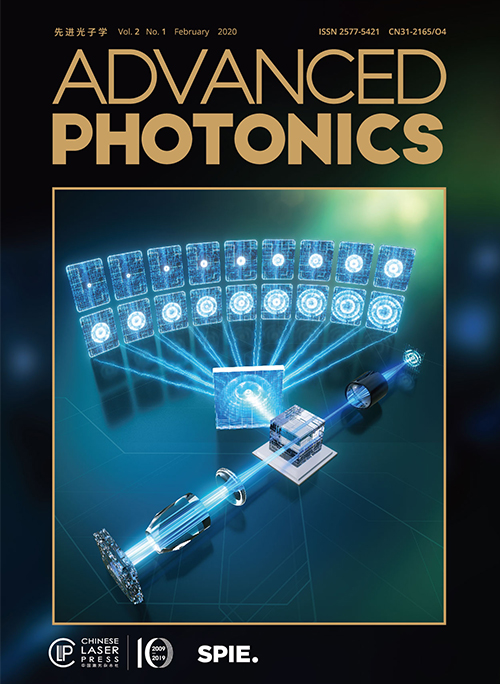 View fulltext
View fulltext
The image on the cover of Advanced Photonics Volume 2, Issue 1, demonstrates the principle of compressed ultrafast photography via image encoding and decoding. The dynamic scene (shock wave) is spatially encoded by DMD and temporally sheared by streak camera, which is recovered through compressed sensing algorithm with high imaging speed of trillion frames per second. Provided by S. Zhang et al., a team of researchers from East China Normal University, the image is based on the research presented in their article, “Single-shot compressed ultrafast photography: a review”.
In this editorial, the co-editors look back on the journal’s first year.
Terahertz science and technology promise many cutting-edge applications. Terahertz surface plasmonic waves that propagate at metal–dielectric interfaces deliver a potentially effective way to realize integrated terahertz devices and systems. Previous concerns regarding terahertz surface plasmonic waves have been based on their highly delocalized feature. However, recent advances in plasmonics indicate that the confinement of terahertz surface plasmonic waves, as well as their propagating behaviors, can be engineered by designing the surface environments, shapes, structures, materials, etc., enabling a unique and fascinating regime of plasmonic waves. Together with the essential spectral property of terahertz radiation, as well as the increasingly developed materials, microfabrication, and time-domain spectroscopy technologies, devices and systems based on terahertz surface plasmonic waves may pave the way toward highly integrated platforms for multifunctional operation, implementation, and processing of terahertz waves in both fundamental science and practical applications. We present a review on terahertz surface plasmonic waves on various types of supports in a sequence of properties, excitation and detection, and applications. The current research trend and outlook of possible research directions for terahertz surface plasmonic waves are also outlined.
In the near future, single-molecule surface-enhanced Raman spectroscopy (SERS) is expected to expand the family of popular analytical tools for single-molecule characterization. We provide a roadmap for achieving single molecule SERS through different enhancement strategies for diverse applications. We introduce some characteristic features related to single-molecule SERS, such as Raman enhancement factor, intensity fluctuation, and data analysis. We then review recent strategies for enhancing the Raman signal intensities of single molecules, including electromagnetic enhancement, chemical enhancement, and resonance enhancement strategies. To demonstrate the utility of single-molecule SERS in practical applications, we present several examples of its use in various fields, including catalysis, imaging, and nanoelectronics. Finally, we specify current challenges in the development of single-molecule SERS and propose corresponding solutions.
Compressed ultrafast photography (CUP) is a burgeoning single-shot computational imaging technique that provides an imaging speed as high as 10 trillion frames per second and a sequence depth of up to a few hundred frames. This technique synergizes compressed sensing and the streak camera technique to capture nonrepeatable ultrafast transient events with a single shot. With recent unprecedented technical developments and extensions of this methodology, it has been widely used in ultrafast optical imaging and metrology, ultrafast electron diffraction and microscopy, and information security protection. We review the basic principles of CUP, its recent advances in data acquisition and image reconstruction, its fusions with other modalities, and its unique applications in multiple research fields.
Terahertz (THz) wave generation from laser-induced air plasma generally requires a short temporal laser pulse. In contrast, it was observed that THz radiation from ionized liquid water prefers a longer pulse, wherein the mechanism remains unclear. We attribute the preference for longer pulse duration to the process of ionization and plasma formation in water, which is supported by a numerical simulation result showing that the highest electron density is achieved with a subpicosecond pulse. The explanation is further verified by the coincidence of our experimental result and simulation when the thickness of the water is varied. Other liquids are also tested to assure the preference for such a pulse is not exclusive to water.
Phase is a fundamental resource for optical imaging but cannot be directly observed with intensity measurements. The existing methods to quantify a phase distribution rely on complex devices and structures and lead to difficulties of optical alignment and adjustment. We experimentally demonstrate a phase mining method based on the so-called adjustable spatial differentiation, by analyzing the polarization of light reflection from a single planar dielectric interface. Introducing an adjustable bias, we create a virtual light source to render the measured images with a shadow-cast effect. From the virtual shadowed images, we can further recover the phase distribution of a transparent object with the accuracy of 0.05λ RMS. Without any dependence on wavelength or material dispersion, this method directly stems from the intrinsic properties of light and can be generally extended to a broad frequency range.














